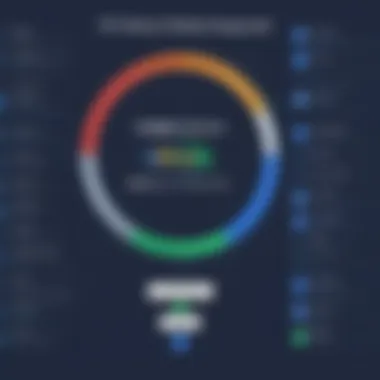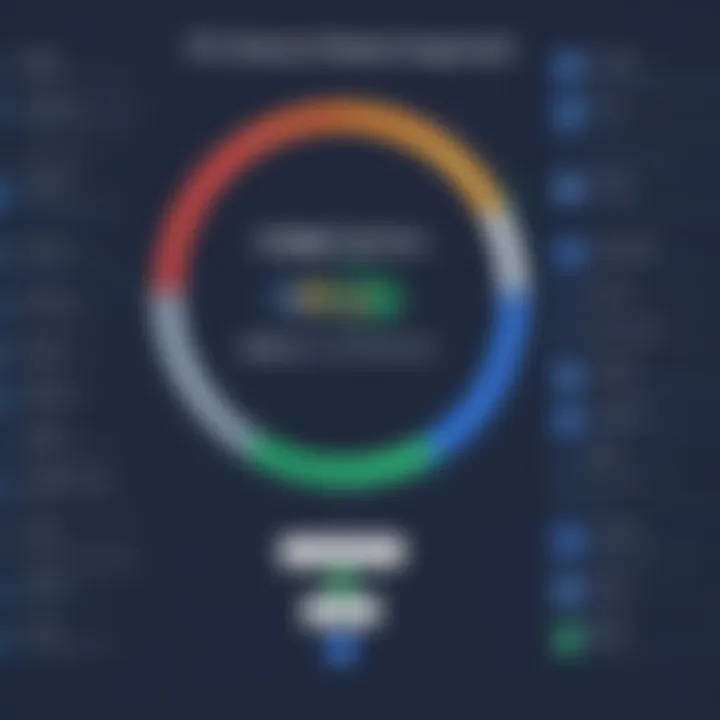Top PPC Platforms: A Comprehensive Analysis


Intro
In an age where every click counts, the landscapes of online marketing is nothing short of a ruthless arena. Pay-per-click advertising, better known as PPC, stands as a primary avenue for businesses looking to make their mark on the digital horizon. While there’s no shortage of platforms available, a few prominent players dominate the field, each offering unique tools and functionalities that can make or break marketing campaigns.
Understanding the mechanics behind these systems is vital, not just for marketing teams but for business operators at all levels. This article pulls back the curtain on popular PPC systems like Google Ads, Bing Ads, and social media platforms such as Facebook Ads. It will dive into the technical nitty-gritty and deliver insights that can help organizations to utilize these platforms effectively.
In the sections that follow, we will dissect various elements from technological advancements that shape PPC systems to data analytics that provide the backbone for smart decisions. The goal is simple: equip professionals, entrepreneurs, decision-makers, and tech enthusiasts with the knowledge needed to navigate this ever-evolving landscape.
Foreword to PPC Advertising
In today’s bustling digital marketplace, understanding how to capture attention is key. This is where Pay-Per-Click (PPC) advertising comes into play. Not only is it a crucial tool for many businesses, but it can also make or break an online marketing strategy. This section aims to dissect the various facets of PPC advertising and why it holds such significance in the realm of digital marketing.
Definition of Pay-Per-Click
At its core, Pay-Per-Click is a model of Internet marketing where advertisers pay a fee each time their ad is clicked. Essentially, it’s a way of buying visits rather than attempting to “earn” those visits organically. A classic example would be Google Ads, where businesses bid for ad placement when users search for specific keywords. When someone clicks on your ad, that’s when you incur a cost.
This approach could be better understood with a simple analogy: you’re paying for a prime seat at a concert rather than hoping to be noticed in the crowd.
In simpler terms, PPC offers a short-cut to getting traffic, allowing businesses of all sizes to appear in front of potential customers without having to build up an extensive organic presence.
Importance of PPC in Digital Marketing
PPC is not merely a money-spending venture; it is a strategic play. It enables businesses to reach their audience at precisely the right moment. This is particularly essential in a world where consumers expect instant results and immediate access to information. Here are a few points encapsulating PPC’s significance:
- Immediate Results: Unlike SEO, which can take time to gain traction, PPC can drive web traffic almost instantly. If your ad is optimized well, visibility can lead to conversions within hours.
- Targeted Reach: The ability to target specific demographics—based on keywords, location, age, and interests—ensures that your marketing message reaches those most likely to engage with your product or service.
- Budget Control: Businesses can set a budget and adjust it according to their needs. You only pay for actual clicks, making it easier to manage spending accurately.
- Performance Metrics: With advanced analytics, marketers can measure the effectiveness of ad campaigns in real time, allowing for quick adjustments and optimizations.
In summary, PPC presents an opportunity to bridge the gap between company outreach and consumer need. For businesses aiming to enhance their visibility and stay competitive, understanding and utilizing PPC advertising is non-negotiable.
Overview of Leading PPC Platforms
Understanding the landscape of pay-per-click (PPC) advertising is imperative for any business looking to boost its online presence. The effectiveness of PPC is largely influenced by the platforms used to run these campaigns. Each platform comes with its own strengths and weaknesses, catering to different market segments and advertising objectives.
Choosing the right PPC system can be a determining factor between campaign success and failure. Companies often analyze factors such as audience reach, cost-effectiveness, and targeting options when selecting a PPC platform. Therefore, an overview of the leading PPC systems is not just informative; it's crucial for strategic decision-making in marketing.
"The best PPC platform does not just serve ads but connects with the audience in a meaningful way."
Google Ads
Google Ads is widely regarded as the giant in the PPC space. With its unparalleled reach through search results and the Google Display Network, businesses can tap into a massive audience.
One standout feature is the ability to use sophisticated keyword targeting, which allows advertisers to show their ads to users actively searching for specific terms related to their products or services. Additionally, the platform offers robust tools for ad creation, enabling a range of formats from text to video ads. The return on investment can be significant, given the immense scale and potential for high click-through rates.
Another key aspect is the integration with Google Analytics, which provides insights into user behavior and campaign performance, allowing advertisers to make informed adjustments. This synergy enables more precise targeting, making Google Ads a versatile choice for various marketing goals.
Microsoft Advertising
Though sometimes overshadowed by Google, Microsoft Advertising (formerly Bing Ads) is a formidable player in its own right. What sets it apart is its lower competition and, as a result, potentially lower costs for advertisers. Utilizing Microsoft's search engine, Bing, it captures a valuable demographic that often gets overlooked.
The platform features features like audience segmentation and extensive geo-targeting options. Advertisers can customize ads based on user demographics or interests, aligning more closely with specific audience needs. This level of detail in targeting can provide a more personalized experience for potential customers. Plus, the interface is user-friendly, making it more accessible for beginners.
Facebook Ads
Facebook Ads offers a completely different avenue for PPC advertising, focusing primarily on social engagement. With billions of active users, Facebook provides businesses the chance to reach and engage with their target audience within a social context. This platform's strength lies in its ad targeting capabilities, allowing advertisers to narrow down their audience based on interests, behaviors, and demographics, making it possible to reach the most relevant users.
The creative formats available, from carousel ads to video clips, enable storytelling that resonates with audiences in a way that traditional ads oftentimes do not. Additionally, the integration with Instagram further expands the reach, tapping into younger demographics that lean heavily into visual content. The analytics tools available allow advertisers to track engagement and performance metrics, ensuring that dollars spent are generating the desired results.


In summary, a solid understanding of leading PPC platforms—Google Ads, Microsoft Advertising, and Facebook Ads—equips marketers with the knowledge they need to choose wisely. Each platform's unique features and audience targeting abilities contribute to its effectiveness, making the selection process pivotal for achieving marketing objectives.
Key Features of Popular PPC Systems
When it comes to pay-per-click (PPC) advertising, the platforms in play offer a range of features that can either make or break a campaign. Understanding these key characteristics is paramount for any business looking to invest its resources wisely. Ignoring the importance of these features can result in wasted budgets and disappointing ROI. In this section, we'll break down the essential elements that distinguish these systems and what benefits they bring to marketers and advertisers alike.
Ad Targeting Capabilities
In today's rapidly-evolving digital landscape, effective ad targeting is like having a finely-tuned instrument. PPC systems give advertisers the ability to reach their audience with precision. For example, Google Ads provides options like keyword matching and demographic targeting, which enables businesses to hone in on specific customer segments. You can target based on age, location, interests, and even behaviors. It's like casting a fishing net, but instead of catching whatever’s swimming by, you’re after the particular fish that fits your recipe.
Moreover, social platforms like Facebook offer behavior-based targeting, allowing you to reach users based on their online actions. Imagine a clothing brand wanting to promote a new line of eco-friendly activewear; it can directly target environmentally-conscious consumers or fitness enthusiasts based on their likes and interactions.
"The power of precise targeting transforms a generic ad into a personal recommendation."
This level of granularity helps improve click-through rates and conversions, which are core to a successful PPC strategy. Without these capabilities, campaigns could feel like a shot in the dark.
Budget Management Tools
Managing your budget in PPC can feel like walking a tightrope. A good system should equip advertisers with tools that ensure they don’t overspend while maximizing returned value. Google Ads, for instance, offers bidding strategies that align with your goals—whether that be maximizing clicks or conversions. You can set a daily budget or choose a monthly cap, which is crucial for businesses trying to manage cash flow effectively.
With tools like Microsoft Advertising, there’s also an option to adjust bids based on device type, which is particularly valuable as mobile and desktop behaviors differ. It's like placing your bets in the right areas—if you find that mobile users convert better, you can allocate more budget there.
Additionally, features such as automated bidding help take the guesswork out, allowing algorithms to adjust bids based on the likelihood of conversion. This means less time stressing over numbers and more time crafting great ads.
Performance Tracking and Analytics
In the world of PPC, knowledge is power, and performance tracking serves as your apparent flashlight in the dark. Proper analytics tools let advertisers see how every dollar is performing and which efforts yield the best results. Google Ads offers robust reporting features that track everything from impressions to conversions and click-through rates. This can help businesses identify strengths and weaknesses in their campaigns.
Moreover, platforms like Facebook Ads come with their own analytics dashboard where you can gather metrics about audience engagement, reach, and overall campaign performance. Knowing what works allows businesses to pivot quickly, adapting campaigns to maximize their impact. Without such insights, you're practically steering a ship without a compass.
Utilizing performance data not only informs tweaks to ongoing campaigns but also aids in future planning. Identifying trends over time can indicate what strategies resonate with customers and bring them back for more.
In summary, recognizing the critical features of popular PPC systems is essential for any marketer looking to achieve success. From ad targeting abilities that enhance audience engagement to budget management tools that protect your finances, and from robust analytics that track performance to optimizing campaigns, these systems provide the building blocks for informed decision-making and strategic marketing.
Advantages of Utilizing PPC Advertising
Pay-per-click (PPC) advertising has established itself as a cornerstone of digital marketing strategies, offering businesses a pathway to increased visibility and measurable engagement. For any organization looking to make a splash in the bustling online marketplace, leveraging PPC can be a game changer. In this section, we’ll delve into the specific advantages that make PPC a preferred choice for many marketers. Each element not only enhances brand presence but also aligns with contemporary marketing trends and consumer behavior. Let’s explore these key benefits in detail.
Immediate Visibility
In the world of online advertising, time is of the essence. One of the most compelling advantages of utilizing PPC is the immediate visibility it affords brands. Unlike organic search strategies that may take months to show results, a well-crafted PPC campaign can elevate your online presence almost instantaneously.
As soon as a campaign goes live, ads can appear on search engine results pages or social media feeds, depending on the platform. This quick access can be a lifesaver for seasonal businesses or those launching new products who need to gain traction quickly.
- Highly Targeted Exposure: PPC allows precise targeting based on factors like keyword selection, demographic information, and geo-location. This ensures that the right audience sees your ads, enhancing the likelihood of engagement.
- Control Over Budget: With PPC, organizations set their budgets. Even with a modest budget, ads can appear in prime locations, providing remarkable visibility without emptying the coffers.
This immediate access isn’t just about advertising speed; it is also about being relevant when consumer interest peaks. Companies can launch promotions or announcements and capture attention right when it's most valuable.
Measurable Results
Another substantial advantage of PPC advertising lies in its emphasis on measurable results. In a landscape where every click counts, understanding ROI is crucial for marketers and business leaders alike.
Platforms like Google Ads and Facebook Ads provide comprehensive analytics tools that help businesses track various metrics, including:
- Click-Through Rate (CTR): Understanding how many people clicked on your ad versus how many saw it is crucial for assessing its appeal.
- Conversion Rate: This metric determines how well your ads convert traffic into valuable customer actions, such as purchases or sign-ups.
- Cost Per Click (CPC): This allows organizations to calculate the spend per individual click on their ads, giving insight into budget efficiency.


Having access to this data not only sheds light on what's working but also informs future strategy adjustments. Decisions can be made based on hard data rather than hunches, promoting a more scientific approach to marketing.
"In the realm of PPC, what gets measured gets improved."
Being able to track and analyze results in real-time enables businesses to swiftly pivot and refine their campaigns, making them more adaptive to emerging trends or consumer responses.
Customizable Campaigns
Unlike more rigid advertising strategies, PPC offers the flexibility of customizable campaigns, allowing businesses to tailor their advertising efforts to meet specific goals and audience needs.
- Audience Segmentation: Advertisers can segment their audiences and create different ads for each demographic. This is particularly effective when targeting diverse customer groups, as ads can be customized to resonate with various interests and behaviors.
- Ad Formats and Creative Elements: Different platforms offer a variety of ad formats — including text, image, video, or carousel ads — which can be altered according to the campaign goal.
- A/B Testing: There’s also an opportunity for A/B testing. By running multiple variations of ads simultaneously, businesses can gather data on which version performs better, ensuring higher engagement in future endeavors.
This spectrum of customization helps brands to harness the full potential of their advertising dollars. It allows them to engage consumers effectively and adapt on-the-fly, meeting their audience's unique expectations.
In summary, the advantages of PPC advertising—immediate visibility, measurable results, and customizable campaigns—provide businesses with effective tools to navigate the competitive digital landscape. As such, these benefits not only elevate brand presence but also ensure that marketing strategies remain agile and impactful.
Challenges Associated with PPC Advertising
In the realm of digital marketing, pay-per-click (PPC) advertising stands as a formidable tool, yet it is not without its challenges. Understanding these hurdles is essential for any business looking to invest time and resources into PPC campaigns. Delving into the difficulties associated with PPC not only highlights potential pitfalls but also prompts practical strategies to navigate them effectively. Considering cost management, ad fatigue, and the ever-evolving nature of advertising platforms, this section sheds light on the nuanced landscape businesses must traverse.
Cost Management Issues
Managing costs in PPC advertising is akin to balancing a finely tuned scale. The inherent nature of the pay-per-click model means that every click can chip away at your budget in real-time. Without diligent oversight, expenses can spiral, resulting in campaigns that eat up funds faster than they generate returns. It's paramount for companies to utilize budget management tools and set strict limits to avoid this predicament.
- Keyword Bidding: One of the primary contributors to escalating costs is competitive keyword bidding. In a saturated market, high-value keywords can push costs to dizzying heights. Regular keyword analysis is critical for identifying high-performing keywords and reallocating resources effectively.
- Click Fraud: A significant concern is click fraud, wherein bots or competitors generate fake clicks, inflating costs without yielding genuine interest. Businesses should implement tracking measures to identify suspicious activity and protect their investments.
Ad Fatigue and Quality Score
Ad fatigue emerges when prospective customers see the same ad too often, leading to a decline in engagement. This phenomenon not only diminishes the effectiveness of ad campaigns but can also negatively impact the Quality Score on platforms like Google Ads. Quality Score, a key metric influencing ad placements, relies heavily on engagement measures such as click-through rate and ad relevance.
To combat ad fatigue, businesses should diversify their ad creatives and refresh them regularly:
- Ad Rotation: Implementing a rotation of different ad versions can keep the audience engaged. Testing numerous iterations helps in determining what resonates most with potential customers.
- Audience Segmentation: Tailoring ads to specific audience segments can also help maintain interest and reduce the chance of fatigue. By analyzing insights about various demographics, businesses can craft targeted messages that resonate more deeply with each group.
Navigating Platform Changes
PPC platforms are continually evolving, with algorithms and policies that change more often than many may realize. Staying abreast of these shifts is vital for the success of PPC strategies. Inattention to platform updates can lead to underperformance or wasted budgets.
- Algorithm Updates: Major platforms like Google Ads frequently roll out algorithm changes that may affect ad ranking and visibility. Regularly checking for announcements and understanding these updates ensures that businesses can adapt strategies accordingly.
- Platform Policies: Similar to algorithms, advertising policies may change, impacting what types of ads can be run or how they are billed. Ignoring these updates can lead to penalties or the suspension of accounts, stifling advertising efforts.
Navigating the complexities of PPC advertising can feel like a tricky dance, requiring both finesse and vigilance. By recognizing and addressing these challenges, companies are better positioned to leverage PPC for their growth.
"In the world of PPC advertising, ignorance is not bliss—it's a budgetary black hole."
Ultimately, a proactive approach to understanding and managing challenges can transform potential stumbling blocks into stepping stones, leading to more successful and sustainable advertising efforts.
Comparative Analysis of PPC Systems
A comparative analysis of PPC systems is essential for businesses that seek to make informed decisions about their online advertising strategies. Each platform has its own set of strengths and weaknesses. By understanding these differences, marketers can tailor their campaigns more effectively, ensuring that they reach their target audience in the most efficient manner possible. Moreover, the competitive nature of digital advertising necessitates that advertisers not only recognize what each system offers but also how they can leverage these platforms to their advantage. This analysis enables organizations to optimize budget allocation and maximize return on investment.
Google Ads vs. Microsoft Advertising
When comparing Google Ads with Microsoft Advertising, several elements come into play. First, it's critical to recognize that Google Ads dominates the market, accounting for a significant share of search engine traffic. This dominance translates into a wider reach, making it an attractive option for many businesses.
Nevertheless, Microsoft Advertising, which encompasses the platforms like Bing, can offer unique advantages that shouldn't be overlooked.


- Audience Reach: Google Ads boasts an extensive audience, catering to billions of searches. However, Microsoft Advertising captures a unique demographic, especially among older, more affluent users; they often have higher disposable income.
- Cost-Effectiveness: Advertisers might find better cost-per-click rates with Microsoft Advertising. Given less competition than Google, the lower costs can allow businesses to stretch their marketing budgets further.
- Ad Formats and Innovations: Google often leads in ad innovations, such as responsive search ads and advanced targeting options. Microsoft, on the other hand, offers features like LinkedIn integration, which can particularly benefit B2B advertisers.
Even though Google Ads might be the go-to for many, the comparative advantages of Microsoft Advertising mean businesses should assess their own goals before choosing a platform. An effective strategy could incorporate campaigns on both to capture a broader audience and optimize results.
Facebook Ads vs. Instagram Ads
In the world of social media advertising, Facebook Ads and Instagram Ads often come into play in similar conversations, but understanding the subtle distinctions between the two can enlighten marketers on the best paths forward.
- User Base: While both platforms share a significant user base, they attract different demographics. Facebook is more family-oriented and appeals to an older audience, while Instagram caters more to younger users—particularly millennials and Gen Z.
- Visual Content: Instagram is inherently a visual platform. For businesses that can produce high-quality imagery or video, Instagram Ads can yield impressive engagement rates. In contrast, Facebook offers more text-heavy options, allowing for detailed messaging that can resonate with an audience looking for depth.
- Ad Placement and Strategy: Advertisers can run campaigns across both platforms simultaneously, but the effectiveness of an ad may differ. Instagram excels with visually dynamic content like stories and carousels, whereas Facebook ads may perform better with longer form content or direct calls-to-action that outline more intricate offers.
Interestingly, many brands find it beneficial to strategize for both platforms, utilizing the strengths of each to foster engagement. Social media advertising isn’t a one-size-fits-all approach, and understanding these nuanced differences can lead to a more efficient allocation of resources.
"In today's complex digital marketing ecosystem, businesses that evaluate the precise platforms needed for their campaigns are often the most successful."
Analyzing PPC systems side by side reveals not just the functionalities of each but also the unique opportunities that can be harnessed to amplify an organization's digital presence. Understanding these distinctions ultimately enables more calculated decisions when planning advertising strategies.
Future Trends in PPC Advertising
The landscape of PPC advertising is always transforming. As we look ahead, it’s crucial to understand emerging trends that can redefine how businesses approach their marketing strategies. This section delves into the significant shifts on the horizon and their implications for marketers eager to stay competitive.
Automation and AI in PPC
Automation is becoming the backbone of many advertising strategies, particularly in PPC. The introduction of artificial intelligence can immensely change the way ads are managed. Not only does AI enable more efficient ad creation, but it also optimizes bidding strategies in real-time, learning from user behavior and adjusting accordingly.
Imagine setting up a campaign, and as you hit “launch,” AI algorithms take the reins. They analyze audience data, apply machine learning to find trends, and adjust bids to ensure optimal ad placement without constant oversight. This not only saves time but can also lead to better ROI.
Here are a few ways automation and AI are impacting PPC:
- Dynamic Ads: These adapt based on user interaction and preferences, creating a personalized experience that boosts engagement.
- Smart Bidding: This includes strategies like target CPA (Cost Per Acquisition) that leverage machine learning to maximize the chances of achieving specific goals.
- Predictive Analysis: AI systems can forecast trends based on data, allowing marketers to be proactive rather than reactive in their strategies.
This integration doesn’t just enhance efficiency; it provides actionable insights that can guide future campaigns. The potential for automation is vast, and companies that embrace these technologies are likely to reap significant rewards.
Integration with Other Marketing Channels
PPC advertising does not exist in a vacuum. Its effectiveness skyrockets when integrated with other marketing channels. By creating a cohesive strategy that combines multiple touchpoints—be it email, social media, or content marketing—businesses can create an omnichannel experience for their audience.
Consider the following elements:
- Synergy with SEO: PPC and SEO can complement each other beautifully. Running Google Ads alongside an optimized website can ensure visibility on both paid and organic fronts.
- Cross-channel Remarketing: Users who engage with ads can be retargeted across various platforms, making it more likely they will convert. For instance, a user sees a product on Facebook and, later on, encounters it again through a Google search.
- Unified Data Analysis: Integrating data from different channels can provide a holistic view of customer behavior. Marketers can glean insights on what works and what doesn’t, leading to a more refined strategy.
As we move forward, these integrations will become essential for a well-rounded marketing approach. By leveraging the strengths of PPC alongside other channels, businesses can enhance their reach and drive more efficient conversions.
"The future of PPC isn’t just in clicks, but in connections across platforms."
Culmination
Bringing down the curtain on our exploration of PPC systems reveals not only their operational mechanics but their profound impact on digital marketing strategies. As we sift through the discussions, it's clear that PPC advertising is much more than just a financial transaction; it’s a gateway to fostering brand visibility and effectively engaging target audiences.
Recap of Key Insights
In this article, we've covered several pivotal points regarding pay-per-click advertising:
- Diverse Platforms: From Google Ads to Facebook Ads and Microsoft Advertising, each system has its unique strengths and target demographics.
- Key Features: Different platforms offer various capabilities in ad targeting, budget management, and performance analytics, which can influence a marketer's choice.
- Advantages and Challenges: Immediate visibility and measurable results are some benefits, while cost management issues and platform changes pose challenges.
- Future Trends: Automation and AI are projected to play a bigger role in optimizing PPC campaigns, making adaptability a crucial trait for marketers.
These insights underscore the importance of understanding how each platform operates and the strategic benefits they provide.
Final Thoughts on PPC Adoption
As the digital landscape evolves, embracing PPC advertising will only become more relevant for businesses aiming to stay competitive. It's not simply about putting ads up and hoping for clicks. Strategic planning, ongoing assessment, and adaptability to new trends will be necessary for any organization hoping to leverage PPC successfully.
Investing time into understanding the nuances of these systems can lead to more effective campaigns, potentially translating into increased revenue and customer engagement. Whether you are a small business looking to make a mark or a large corporation aiming for market dominance, the right PPC approach can act as the cornerstone of your online marketing strategy.
In summary, the right knowledge and tools can make all the difference. Strike while the iron is hot and consider how PPC could be your stepping stone to greater online presence and success.







